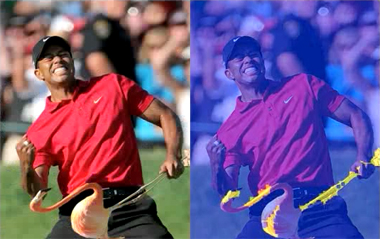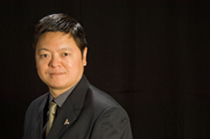Scientists Develop Method for Authenticating Digital Images by Analyzing 'Noise'
 |
|
At left, doctored photo of Tiger Woods and a flamingo as a golf club; at right, the exposing of differences in noise variance between Woods (low) and flamingo (high) elements. |
ALBANY, N.Y. (June 25, 2012) – University at Albany Computer Scientist Siwei Lyu and colleagues, working in partnership with the New York State Center for Information Forensics and Assurance (CIFA), have identified a new method using “noise” to authenticate digital photography. The research is supported by a grant from the National Science Foundation (NSF).
The team presented its findings for exposing digital image splicing by measuring "noise" levels discerning discrepancies in photos at the IEEE International Conference on Computational Photography.
"Whenever a photo is manipulated digitally, the underlying characteristics of the image pixels are disturbed in a way that they become unnatural,” Lyu explains. “Though human eyes may not be able to detect such subtle changes, they can be readily picked up by computer algorithms. The techniques developed aim to make sure that more significant manipulations can be detected."
 |
|
Siwei Lyu of the College of Computing and Information
|
Noise, the digital equivalent of film grain, exists in all digital photography, and is generally invisible to the human eye. Numerous factors during and after a photo is taken introduce noise, such as temperature and thermal conditions, sensor saturation, quantization, compression, and transmission. While an unaltered image is expected to have uniform noise strength across all pixels, inconsistencies in noise variances in altered photos become telltale evidence of tampering.
Using statistical and computational analysis, Lyu's team developed techniques that effectively measure noise strength across a photo to determine which parts of the photo originated from different sources.
According to Lyu, the method is advantageous in that it does not explicitly rely on the knowledge of image format, camera model, or tampering procedure, and has a high level of detection accuracy.
The past decade has witnessed significant advances in digital image processing and computational photography, resulting in sophisticated image-editing software systems such as Adobe Photoshop and GNU Image Manipulation Program. Yet the ease of digital image manipulation has also posed new challenges, with digital images becoming more vulnerable than their non-digital counterparts to malicious tampering.
"Collectively," Lyu said, "the digital image forensic community aims to provide a series of tools that can significantly limit the extent of undetectable manipulations, or increase the real cost, in terms of time and technical sophistication, of making a believable forgery."
Learn more about Lyu's work in
digital forensics, or explore UAlbany's College of Computing
and Information. For more UAlbany news, visit the News Center.
![]() For more news, subscribe to UAlbany's RSS headline feeds
For more news, subscribe to UAlbany's RSS headline feeds
A comprehensive public research university, the University at Albany-SUNY offers more than 120 undergraduate majors and minors and 125 master's, doctoral and graduate certificate programs. UAlbany is a leader among all New York State colleges and universities in such diverse fields as atmospheric and environmental sciences, business, education, public health,health sciences, criminal justice, emergency preparedness, engineering and applied sciences, informatics, public administration, social welfare and sociology, taught by an extensive roster of faculty experts. It also offers expanded academic and research opportunities for students through an affiliation with Albany Law School. With a curriculum enhanced by 600 study-abroad opportunities, UAlbany launches great careers.


